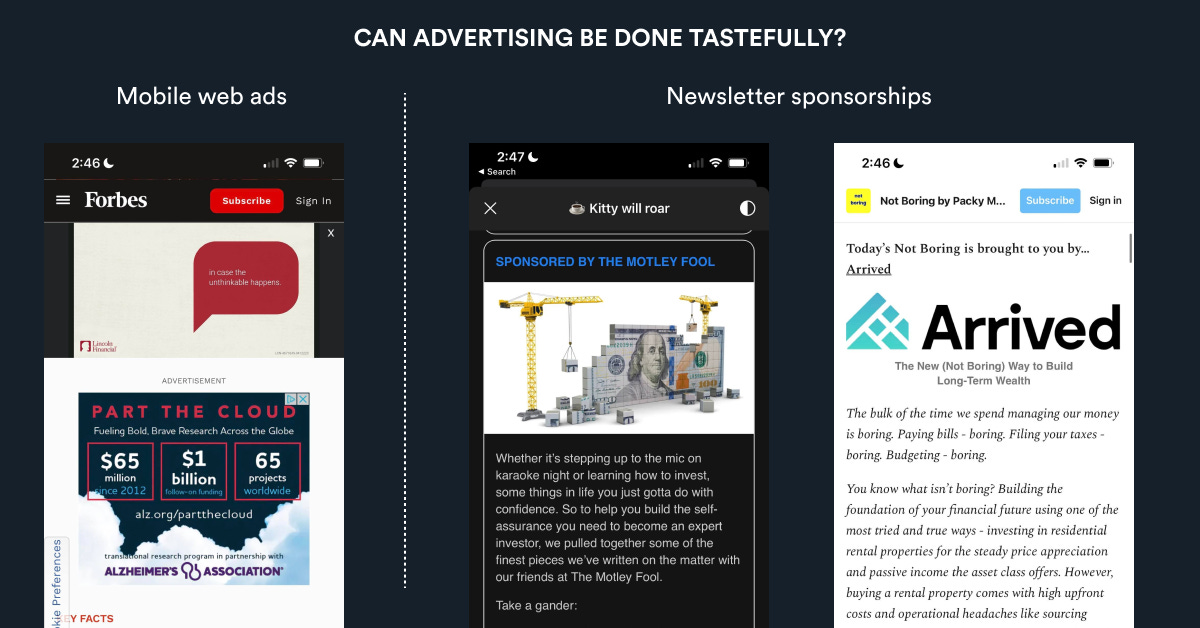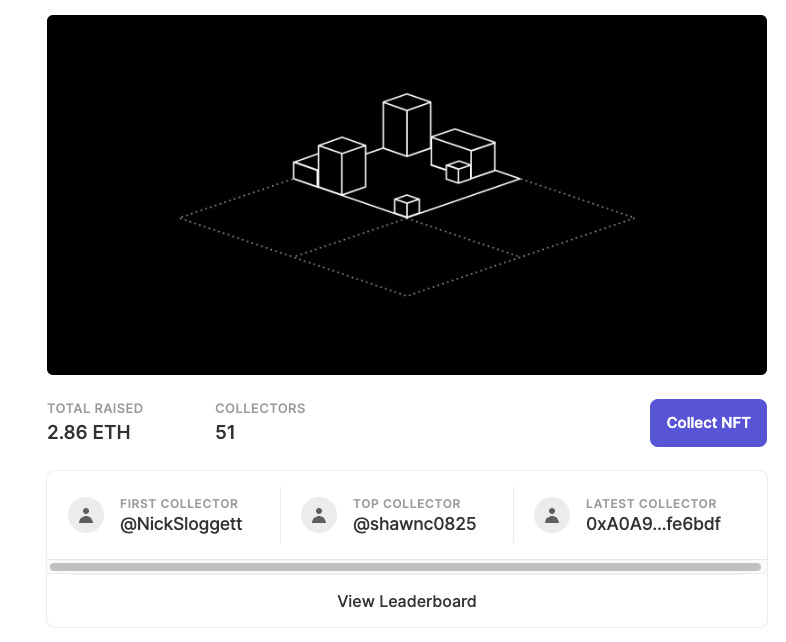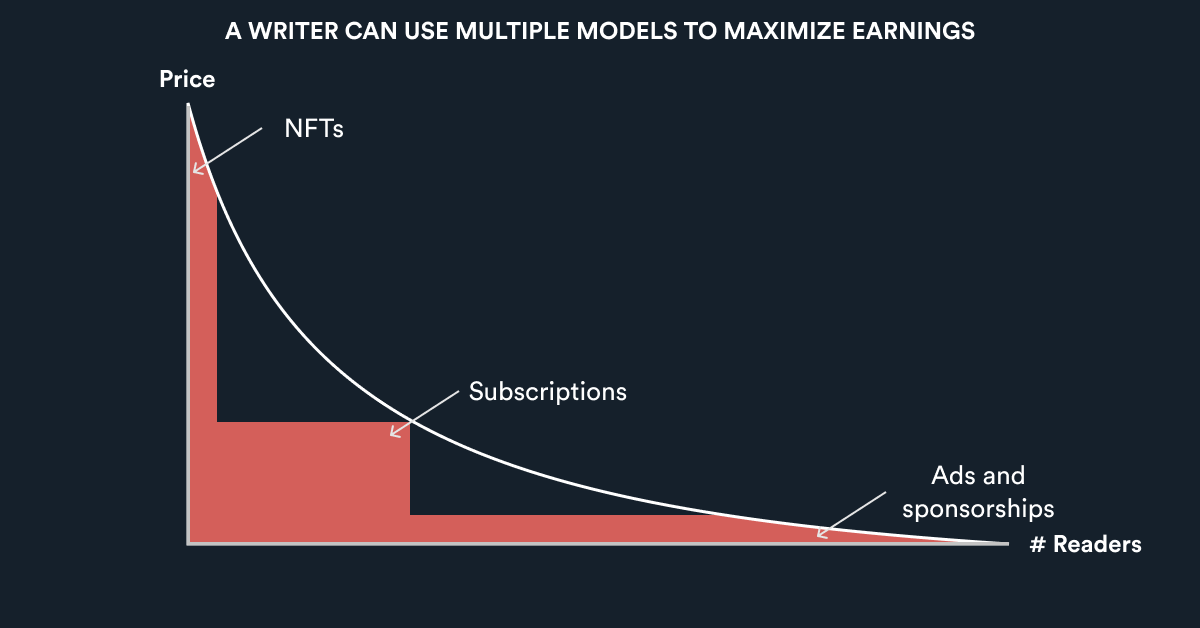What's the Right Business Model for Good Writing?
What's the Right Business Model for Good Writing?A closer look at the pros and cons of ads, subscriptions, and NFTsDear subscribers, What’s the right business model for good writing? Many platforms have strong opinions about how writers should make a living:
So what’s the answer? Let’s dive into a writer’s needs and evaluate each model below. Today’s post is brought to you by…Continuum Continuum is an education platform that lets you earn crypto rewards as you learn:
Visit the website below and download the app to start learning for free! A writer’s hierarchy of needsI wrote about a creator’s hierarchy of needs a few years ago. A writer is a creator that cares about “love, fame, money” as follows:
Platforms that help writers make money also need to think about “love” and “fame.” Keep these needs in mind as we explore the business models below. AdvertisingThe ads model is simple: Get your writing in front of as many readers as possible and hope they click on ads. Ads align well with a writer’s “Fame” need to reach more readers. But once hot publishers like BuzzFeed, Vice, and Vox are struggling (Buzzfeed’s stock is down 80%+ since it went public). There are several problems with ads:
So is advertising 100% evil? I don’t think so.
Consider the following newsletters that run on ad sponsorships:
I chose sponsorships over subscriptions for this humble newsletter because I want as many people to read it as possible. To recap, here are the pros and cons of advertising:
SubscriptionsLet’s look at subscriptions through two writing platforms - Medium and Substack. Medium pivoted from ads to subscriptions in 2017 after then CEO Ev Williams wrote:
Instead of ads, readers subscribe to Medium which then decides how much to pay each writer based on reading time. This model has led to memes like: Medium had 700K paid subscribers and made ~$35M in 2021. However, as Nathan wrote, this model doesn’t attract the best writers who would rather own their audience and brand. Substack also started in 2017 with a similar mission:
The difference, of course, is that Substack lets writers own their audience and brand through email. With Substack, readers subscribe to the writer directly. Substack had over 1 million paid subscribers and made $9M in 2021. The company wants to help writers make their subscriptions more valuable. Consider Lenny, who offers several benefits through his subscription:
But even Lenny has written about how he spends a lot more time on his free posts than the paid ones. That’s because the free posts bring in new readers while paid posts have limited reach. To its credit, Substack has built a recommendation feature that’s been critical in helping writers grow. But it sucks to spend hours writing a great post only to paywall it to 10% of your audience. Furthermore, many Substack writers monetize through sponsorships and the company gets 0% of that revenue. Its 100% anti-ad stance has also opened the door to competitors:  To recap, here are the pros and cons of sponsorships:
NFTsNFTs are an emerging monetization channel for writers. Consider Mirror, a web3 publishing tool that:
It’s still early days for Mirror. The platform has 80K accounts and has helped creators raise 11K eth ($16M). If anything, I think Mirror has more potential as a crowdfunding tool than a writing platform. NFTs can also be an alternative to subscriptions for bringing a writer’s 1,000 true fans together in a community. I’ve written at length about how this might work. To recap, here are the pros and cons of NFTs:
So what’s the right business model for good writing?
Some writers want to reach millions of readers. Others enjoy writing for a tight-knit community of paid subscribers. Still others use multiple models to segment reader willingness to pay: I think writing platforms are too opinionated about how writers should make money. Instead, they should empower writers to pick the right model themselves. A good example is Every, which helps writers monetize through subscriptions, sponsorships, and even NFTs. Writers just want to focus on writing. Platforms that make it easy for writers to find sponsors, subscribers and more will win long term. P.S. One of my favorite newsletters is The Publish Press by long-time Youtubers Colin and Samir. They do a great job breaking down the creator business and curating the most important creator news stories. Join over 30,000 readers by signing up below: If you liked this post from Creator Economy by Peter Yang, why not share it? |
Older messages
The 2022 Crypto Credit Crisis Explained
Thursday, July 14, 2022
The global crypto market has lost $1.2 trillion dollars since April 2022 and multiple crypto companies are facing bankruptcy. Just WTF happened? Here's how a few greedy players (LUNA, 3AC, and
Is Play to Earn Gaming a Ponzi Scheme?
Wednesday, June 29, 2022
Is play to earn gaming a ponzi scheme? In this post, I dive into what play to earn is, case studies on Axie Infinity and STEPN, and how web3 gaming might become sustainable.
Nouns: How One NFT Every Day Forever Built a $34M Brand
Friday, June 17, 2022
Let's talk about Nouns DAO, one of the most interesting NFT projects out there. In this post, we'll cover how Nouns DAO works, the wacky world of Nouns projects, and if Nouns DAO is actually
Practical Lessons from Building a DAO
Wednesday, June 1, 2022
Dear subscribers, Let's talk about what it's actually like to build a DAO (decentralized autonomous organization) from scratch. I've been building Odyssey DAO over the past six months with
How to Build a Thriving NFT Membership Community
Wednesday, May 18, 2022
I believe that NFT memberships are how 1000 true fans will be realized. Let's take a look at how you can build a thriving NFT membership community by examining three of the best: VeeFriends,
You Might Also Like
🌎 Make international sourcing and shipping easier
Tuesday, March 4, 2025
How to prep your business for changing trade regulations. ͏ ͏ ͏ ͏ ͏ ͏ ͏ ͏ ͏ ͏ ͏ ͏ ͏ ͏ ͏ ͏ ͏ ͏ ͏ ͏ ͏ ͏ ͏ ͏ ͏ ͏ ͏ ͏ ͏ ͏ ͏ ͏ ͏ ͏ ͏ ͏ ͏ ͏ ͏ ͏ ͏ ͏ ͏ ͏ ͏ ͏ ͏ ͏
🦅 How was the masterclass with Arvid Kahl?
Tuesday, March 4, 2025
Your feedback matters + Access the recording ͏ ͏ ͏ ͏ ͏ ͏ ͏ ͏ ͏ ͏ ͏ ͏ ͏ ͏ ͏ ͏ ͏ ͏ ͏ ͏ ͏ ͏ ͏ ͏ ͏ ͏ ͏ ͏ ͏ ͏ ͏ ͏ ͏ ͏ ͏ ͏ ͏ ͏ ͏ ͏ ͏ ͏ ͏ ͏ ͏ ͏ ͏ ͏ ͏ ͏ ͏ ͏ ͏ ͏ ͏ ͏ ͏ ͏ ͏ ͏ ͏ ͏ ͏ ͏ ͏ ͏ ͏ ͏ ͏ ͏ ͏ ͏ ͏ ͏ ͏ ͏ ͏ ͏
Letter from the Editor: Why this year's Digiday Publishing Summit matters
Tuesday, March 4, 2025
It's a new era for the media industry. Eras, actually: There's the AI era, the streaming era, the podcast era, the post-cookie era. In other words, media companies are being forced to evolve,
11 social media skills to master (and how AI can help)
Tuesday, March 4, 2025
Perfect these skills now to stay ahead in 2025 ͏ ͏ ͏ ͏ ͏ ͏ ͏ ͏ ͏ ͏ ͏ ͏ ͏ ͏ ͏ ͏ ͏ ͏ ͏ ͏ ͏ ͏ ͏ ͏ ͏ ͏ ͏ ͏ ͏ ͏ ͏ ͏ ͏ ͏ ͏ ͏ ͏ ͏ ͏ ͏ ͏ ͏ ͏ ͏ ͏ ͏ ͏ ͏ ͏ ͏ ͏ ͏ ͏ ͏ ͏ ͏ ͏ ͏ ͏ ͏ ͏ ͏ ͏ ͏ ͏ ͏ ͏ ͏ ͏ ͏ ͏ ͏ ͏ ͏ ͏ ͏ ͏
🦅 The masterclass with Arvid Kahl starts in 15 minutes
Tuesday, March 4, 2025
Build In Public Without Giving Away Your Business Secrets ͏ ͏ ͏ ͏ ͏ ͏ ͏ ͏ ͏ ͏ ͏ ͏ ͏ ͏ ͏ ͏ ͏ ͏ ͏ ͏ ͏ ͏ ͏ ͏ ͏ ͏ ͏ ͏ ͏ ͏ ͏ ͏ ͏ ͏ ͏ ͏ ͏ ͏ ͏ ͏ ͏ ͏ ͏ ͏ ͏ ͏ ͏ ͏ ͏ ͏ ͏ ͏ ͏ ͏ ͏ ͏ ͏ ͏ ͏ ͏ ͏ ͏ ͏ ͏ ͏ ͏ ͏ ͏ ͏ ͏ ͏ ͏
The Age of Economic Chaos
Tuesday, March 4, 2025
Listen now (7 mins) | To investors, ͏ ͏ ͏ ͏ ͏ ͏ ͏ ͏ ͏ ͏ ͏ ͏ ͏ ͏ ͏ ͏ ͏ ͏ ͏ ͏ ͏ ͏ ͏ ͏ ͏ ͏ ͏ ͏ ͏ ͏ ͏ ͏ ͏ ͏ ͏ ͏ ͏ ͏ ͏ ͏ ͏ ͏ ͏ ͏ ͏ ͏ ͏ ͏ ͏ ͏ ͏ ͏ ͏ ͏ ͏ ͏ ͏ ͏ ͏ ͏ ͏ ͏ ͏ ͏ ͏ ͏ ͏ ͏ ͏ ͏ ͏ ͏ ͏ ͏ ͏ ͏ ͏ ͏ ͏ ͏ ͏ ͏ ͏
The next level of content marketing
Tuesday, March 4, 2025
Content marketing isn't just about creating blog posts. If you're still stuck in that mindset, you're leaving money on the table. The best marketers go beyond traditional content and
📱 Google Gemini’s iPhone Hack
Tuesday, March 4, 2025
AI More human-like than ever. Ready to upgrade? ⚡
ET: March 4th 2025
Tuesday, March 4, 2025
Exploding Topics Logo Presented by: Exploding Topics Pro Logo Here's this week's list of rapidly trending topics, insights and analysis. Topic #1 BlueChew (trends) Chart BlueChew is a
🦅 Masterclass with Arvid Kahl: watch the live stream
Tuesday, March 4, 2025
At 10:00 AM Eastern Time (US and Canada) ͏ ͏ ͏ ͏ ͏ ͏ ͏ ͏ ͏ ͏ ͏ ͏ ͏ ͏ ͏ ͏ ͏ ͏ ͏ ͏ ͏ ͏ ͏ ͏ ͏ ͏ ͏ ͏ ͏ ͏ ͏ ͏ ͏ ͏ ͏ ͏ ͏ ͏ ͏ ͏ ͏ ͏ ͏ ͏ ͏ ͏ ͏ ͏ ͏ ͏ ͏ ͏ ͏ ͏ ͏ ͏ ͏ ͏ ͏ ͏ ͏ ͏ ͏ ͏ ͏ ͏ ͏ ͏ ͏ ͏ ͏ ͏ ͏ ͏ ͏ ͏ ͏ ͏ ͏ ͏








